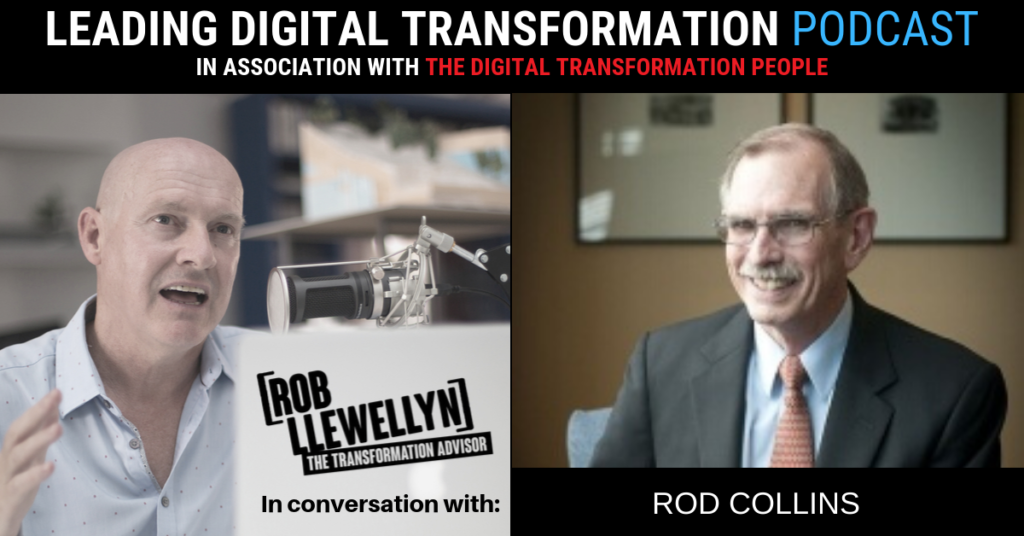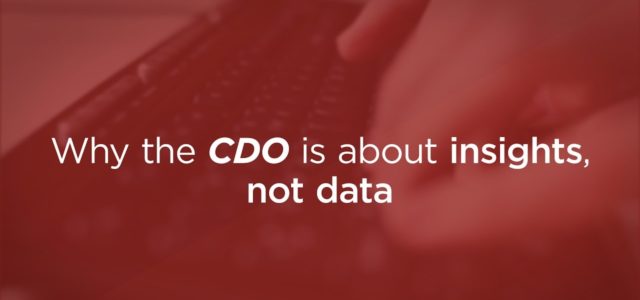‘Leading Digital Transformation’ is a weekly podcast series produced in collaboration between The Digital Transformation People and Rob Llewellyn digital transformation advisor and founder of CXO Transform.
During this series, Rob interviews experienced practitioners, authors and thought leaders whose stories and experiences provide valuable insights for digital transformation success.

In this episode, Rob speaks with Rod Collins, Author, Keynote Speaker, and Director of Innovation at Optimity Advisors. In this episode, Rod presents a masterclass on the power of collective intelligence for innovation and why strategy for 21st-century business needs a new paradigm to succeed.
“What’s happening today and I think at the heart of digital transformation is the fundamental architectural shift in the way that the world works. From centralised top-down hierarchies to distributed peer-to-peer networks, this is the impact of the digital revolution.” ~ Rod Collins
Listen here and read the full transcript below.
Rob Llewellyn [00:00:26] Hi, it’s Rob Llewellyn here, welcome back. Today I’m joined by Rod Collins. Rod is an expert on the future of business. He serves in the dual capacity as the Director of Innovation at Optimity Advisors, a global strategy consulting firm, and as the innovation curator at Salt Flats. Rod’s the author of the book ‘Wiki Management’. And I’m not going to tell you about the book, I’m going to let him do that himself. So, let’s jump into the interview with Rod.
Rob Llewellyn [00:00:56] Rod. Welcome.
Rod Collins [00:00:58] Thank you, Rob. Good to be with you.
Rob Llewellyn [00:01:00] Rod, before we get into a bunch of questions which I want to put to you today, you wrote a book called ‘Wiki Management’. Tell us a little bit about the book.
Rod Collins [00:01:11] Sure. ‘Wiki’ is the Hawaiian word for ‘quick’ or ‘fast’. And if you’re going to survive in terms of managing the 21st-century business, organisations have to be designed to move fast. And so, the book is about a revolutionary, new management model that is being practised by a group of vanguard companies; companies like Google and Amazon and Zappos. And what these companies have learned is that the most effective organisational structures in the 21st century are not centralised top-down hierarchies, but rather distributed peer-to-peer networks. And you lead networks very differently than you lead hierarchies. And the book outlines about 50 practices that are used by these vanguard companies so that companies who want to learn how to manage differently will have a guide for doing that.
Rob Llewellyn [00:02:00] OK, excellent. I’m sure you’re going to touch on some of the subjects which the book covers as we go through our chat today. Rod, I’m looking at an article on managementissues.com and it’s called “From strategic planning to strategic discovery”. Now I think it was in that article, you say that “in times of great change, strategies are not planned, they’re discovered”. What does that mean for today’s managers?
Rod Collins [00:02:25] Well, as I mentioned, we have to manage differently in a rapidly changing world and probably there’s no place that needs to be done more differently than strategy. If you think about it, managers just have two fundamental accountabilities: it’s strategy and execution. Strategy is about doing the right things. Execution is about doing things right. Most companies, most organisations are pretty good at execution, at doing things right. Certainly, Kodak was very good at doing things right. Nobody knew the film better than they did. But the late Peter Drucker had a wonderful saying that I think managers need to keep in mind and to paraphrase it, it’s this: “There’s nothing more useless than doing the wrong thing right.” Doing the right thing, which is the work of strategy, is different in the 21st century than it was in the 20th century. In the 20th century, change was slower. Change was incremental and the pathway to strategy in the 20th century was planning, and we have the term strategic planning. I mean it’s just baked into the DNA of organisations. And when strategy is about planning, the trick is to be able to understand the past, because the past is essentially a proxy for the future. And when this is so, what you want is you want experts leading your organisation who are highly experienced to have a lot of historical knowledge because when planning is the basis for a strategy, you’ll look backwards, you’ll extrapolate out. We have the term forecasting and based upon historical patterns, you can oftentimes predict the future. And this is where most strategic thinking is today. Unfortunately, in a rapidly changing world, it can become a trap, because when the world is changing fast, the past is no longer a proxy for the future. We can’t look backwards to go forwards. Innovation becomes the key strategic concept and what managers and executives have to do in a rapidly changing world is they have to become skilful at Discovery. And so, Discovery is now the foundation for planning, and this requires an entirely different discipline. In strategic planning, the fundamental discipline is analytics. You follow the numbers, and this is why 20th Century management was so numbers-driven. When Discovery is the foundation of strategy, while numbers may be useful, they are merely inputs, but they’re not necessarily directives. What managers have to get good at is an entirely different set of processes and these are emergent processes, these are creative processes and the traditional management model really doesn’t prepare executives for this. Now, this isn’t to discount the analytical skills. They remain important, but what executives have to be skilful at today is both emergent and analytical processes. And oftentimes it is the emergent processes and the things we learned in emergent processes that helped us to inform which analytics are useful and which analytics or not. So again, this is the big paradigm shift in strategy, moving from Planning to Discovery as its foundation.
Rob Llewellyn [00:05:47] OK. So, this shift that you’re proposing, Rod, how is this related to digital transformation?
Rod Collins [00:05:53] OK. Digital transformation. This is a term I think we’re hearing a lot. Some might even call it a buzz word. I think every executive needs to take digital transformation very, very seriously. And the first thing they need to understand is that digital transformation is far more than a technological revolution. It is that, but it is also something much more and much greater. It is probably the single largest sociological revolution in the history of human civilization. I believe that we are going through a true paradigm shift in the way that we socially organize and is the first significant change in ten thousand years, for the entirety of what we know which human civilization, how fundamental forms of social organization have been some form of a centralized top-down hierarchy. These have morphed, these have evolved over those ten thousand years. We started out with tribes, we’ve evolved to corporations. Ten thousand years ago, the way that leaders were replaced was that they got killed. Today, we either fire people or just move on. So, we’ve come up with more humane ways in which we structure these top-down structures. What’s happening today and I think at the heart of digital transformation what it is it is the fundamental architectural shift in the way that the world works. From centralised top-down hierarchies to distributed peer-to-peer networks, this is the impact of the digital revolution. What the digital revolution has done is for the first time, it has made the distributed peer-to-peer network a practical pervasive form of social organisation. Before the Internet, we didn’t have the ability to form networks of large numbers of people and so hierarchical structures were the only ways that we could do it. And these hierarchical structures were tremendous innovations from a sociological perspective. Today, we have an even greater innovation, thanks to the Internet, people can self-organise and one of the interesting things about this digital transformation is architectural shift is these two forms of social organisation are not equal alternatives. A well-formed network always trumps a hierarchy. And this is the great lesson we learned from the Wikipedia story. Wikipedia is a self-organised network made possible by the Internet. Thirty years ago, if we told you the world’s greatest reference would be a self-organised effort of people working without assignments and without pay and that they would end the reign of a two hundred and forty-four-year-old market leader, you would have said: “not going to happen”. Well, that’s exactly what did happen. And so, this is just one example of how networks are superior to hierarchies. And what’s interesting and I think executives need to take note of this as they think about digital transformation and understanding its sociological aspect, in the case of Wikipedia, they didn’t sit down and say let’s come up with a business strategy where we can put the market leader out of business. This was an unintended consequence. And so, businesses need to take note that there is a new competitive factor in the marketplace. And that is if somebody invents a network structure within your business space, you could become an unintended consequence, they could actually put you out of business without intending to do so. This is why we have to look at strategy differently. We’ve got to be looking out and not extrapolating the past, but we need to be looking for how things are changing. We need to get very good at innovation, because I think businesses with their historical assets certainly can be in a position where they can be the disruptors, as opposed to being the disrupted, but it means they have to think about strategy differently and have to use a foundation of discovery, finding innovations, rather than planning trying to extrapolate the past and continuing the status quo.
Rob Llewellyn [00:10:07] Now Rod, you say that the pathway to information and strategic discovery is through emergent processes. How does that work?
Rod Collins [00:10:16] OK. This is very far in for most executives. Again, they’ve been schooled in planning. So, what do you do with planning? Well, you begin with the end in mind. You know exactly what you want to be doing. You do a lot of analysis. And if we can think of architectural blueprints (which I think, by the way, will remain the same because they are fundamentally mechanical), you would never build a building without having the entire thing drawn out in advance. And what we’ve done is we’ve run organisations the way we build buildings. We treat strategy as if it’s a blueprint. That’s what’s shifting. The markets are becoming much more organic and we have to recognize “why are we building something mechanically?” or “when are we building something organically?”
And if we are building something mechanically like a building and I think we’ll continue to do this, blueprints make sense. But increasingly, strategy is more of an organic than a mechanical process. This is why emergent processes are important. So, what we have to do, let’s take for example “knowledge”. In planning, you rely upon experts, experts who have historical knowledge. You get their sense of where things are going. If you’re discovering, you don’t want to necessarily restrict yourself to experts. You want to bring in non-experts and what I like to call “unusual suspects”. You want to bring in large numbers of people, because if you’re going to innovate, the essence of innovation oftentimes is connecting unusual things. And the last people who connect unusual things are experts. The people who are expert at film never thought it would be interesting in one device to combine a phone, a camera, a portal to the Internet, and while we’re at it, we’ll include your entire music collection. No expert would have probably made that connection. Only somebody who is thinking outside the box would do that. And this simple device that combines all four of these, the smartphone, is probably the most significant invention that we’ve seen so far and will probably remain so for maybe a few more years.
[00:12:30] I have a feeling we may see some more game-changing inventions come down the road. And so, it’s important to think differently and get comfortable with these emergent processes and these involve the ability to be creative, which is an entirely different set of skills and the skills to be analytic. And so, what you want to be doing is you want to be tapping into the collective intelligence within your organization.
[00:12:55] And this is one of the significant attributes of the shift from hierarchies to networks. Hierarchies leverage the intelligence of specific individuals. Hierarchies are based upon the assumption that my organization will be smartest, when the smartest people rise to the top and they have the ability to direct, command and control the work about others, such that others will behave smarter than they otherwise would be if left to their own devices. So, hierarchies leverage the individual intelligence of the elite few. Networks work very differently. Networks leverage the collective intelligence of the entire organisation and networks’ working assumption is the way to make an organisation smartest is by tapping into the intelligence of everyone and having the ability to aggregate that intelligence into a higher level of intelligence than any single person would come up with. If anybody’s interested in collective intelligence, there’s a wonderful book that was published in 2006. I think it’s timeless, by James Surowiecki called “The Wisdom of Crowds”. One of the things he points out in “The Wisdom of Crowds”, and this is important if you want to tap into collective intelligence, is you have to have four attributes to have collective intelligence, it’s not just an issue of getting everybody in the room and see what happens. That can be an invitation for anarchy, which is oftentimes what executives fear, that if I don’t maintain tight command and control order, I’ll have anarchy. Anarchy is one possibility, but it’s not the only possibility. You actually can have a higher form of organisation, but you’ve got to have the four attributes in place which Surowiecki talks about. These four attributes are: you have to have diversity of opinion. This is why you want to combine experts / non-experts / unusual suspects. Second thing is: there must be independent thinking. You’ve got to have processes so that people are free to speak their mind no matter how eccentric and Surowiecki makes the point that even the eccentric people have a contribution to make.
[00:15:05] The third is: you need local knowledge, people who are actually close to circumstances. In the case of businesses, they are close to the customer or they’re close to the processes of delivery. The idea that decisions are made just within an executive suite becomes dangerous in a rapidly changing world, because many executives can go a lifetime without ever even interacting with the customer, which really is a sad thing. And the fourth attribute, and this is probably the most important, is the attribute of the aggregation mechanism. There has to be some way to collate the collective intelligence that’s contained across the diversity of people. So, let me give me some examples of collective intelligence where it’s operating within the context of networks and how it makes those networks more powerful.
[00:15:55] And by the way, I would suggest that most of our audience listening (whether they realise it or not) know their collective intelligence is superior to leveraging individual intelligence. And that’s because I would suspect that the vast majority of people on this podcast use Google as their search engine. Google was the last search engine in. Why did it become the dominant search engine so fast? We didn’t need another search engine in 1998, we had Altavista, we had Lycos, most thought Yahoo was going to dominate the market. Each of these early search engines leveraged the intelligence of editorial experts. Search was seen like a library activity. The innovation, the insight that Sergey Brin and Larry Page had was “what would happen if we use the collective intelligence of the users to write the pages?” And what happened is we got better search results. And PageRank, which is their underlying algorithm, is an aggregation mechanism that cuts across diversity of opinion. People are independent to choose what links they want to follow, and you have a lot of local knowledge, people were actually close to the activity that they are involved in. So, all four attributes are met.
And that’s why Google continues to be the most popular search engine. It’s because it leveraged the collective intelligence of users, rather than individual intelligence of so-called educational experts. It’s also why Wikipedia worked. It was self-organised, you had diversity of opinion, you had independent thinking on the part of the writers, you had a lot of local knowledge and the aggregation mechanism was the principle of the Wiki, where Wikipedia said “we will not have competing articles on a particular topic”. The Wiki will be the aggregation mechanism in which people have got to work out their common collective thinking and in the event that that doesn’t happen, it is rare rather than the rule that you will have the hierarchy of Wikipedia step in and close off an endless debate. But in this case, hierarchy is the exception rather than the rule. And before leaving this, I do want to point out that hierarchies are not going away, just as networks are not entirely brand new. I would suggest to our listeners, if they look inside their companies, if their company is a top-down hierarchy, I’m willing to bet that there is a self-organised network of people who have formed themselves, who are politically astute, who know how to break the rules and get away with it, and they are probably helping to add to the success of that company. And if this subterranean network did not exist, the company would probably be in some form of either minor or major trouble. Likewise, in networks, hierarchies will be formed, but the difference is, they’re not prescribed and they’re not permanent. The hierarchies that emerge within networks are more likely to, it’s the followers who are likely to designate leaders and the leaders get to be leaders so long as they continue to make contributions. And so, this description by position goes away and it’s hierarchy more by merit. And that’s what you see in the Wikipedia example.
Rob Llewellyn [00:19:17] Rod, I want to focus in on collective intelligence workshops, because I really think this is something that our audience could consider from a conceptual perspective and perhaps work to implement within their own organizations. Now you’ve mentioned that at those workshops, you’d expect experts, non-experts and unusual suspects. Now, I think most listeners are very familiar with the role of experts in workshops but can you elaborate on (I mean, I know you’ve already done it a little) but can you elaborate more on why non-experts and unusual suspects are necessary and then tell us what their role is in that workshop?
Rod Collins [00:19:58] Yes. Let’s talk quickly about a collective intelligence workshop. It’s something that I actually discovered before the internet. In my own personal biography, I found myself in the mid-90s leading a complex organization, aiming to turn its operations around. And we had been having a hard time and somehow had the insight we lead this like it’s a hierarchy, we’re really a network. It was an affiliation of thirty-nine companies coming together to deliver a seamless product. And so, I recognized we need to learn to lead a network and there were no books on that. So, it was kind of one of the first things we figured that we needed to do things differently. And so, we invented what is now known as the collective intelligence workshop. And what we did, which was rather unusual at the time, is we would gather a meeting of about 50 people from across these 39 organizations. And then when you looked across the 50 people, we’d have a microcosm of the business. So, we had all levels represented, from senior executive leaders down to the analyst hired out of college two weeks ago, we would have every function represented, we would have every geography represented, any dimension of diversity we could think of was represented. And so, the idea is look across the room, like I say, can you have a microcosm of the business. And then we design techniques so that people couldn’t debate. We used high facilitation, things like Post-Its and dots and small group sessions and through these facilitative techniques, they served as the aggregation mechanisms in which we could collate their collective intelligence. And by the way, collective intelligence wasn’t something we had in mind, it’s something that emerged in the process. It was something we discovered. And so, we were able to turn our business around by using this intelligence and then a couple of years later, the internet comes along. And I recognized “oh my goodness”, the internet operates just like our collective intelligence workshops. And once I understood Surowiecki’s four principles, I realized why they were so common. And I feel fortunate to have discovered the dynamics of the Internet and what I would call an analogue situation. Now the reason that experts and non-experts are important (and the usual suspects), is that you need all three. You don’t want a collection of just unusual suspects and non-experts, because you do need a foundation of expert knowledge. But with innovation work, you don’t want to restrict yourself to that, because oftentimes what happens is it’s the combination of a non-expert and an expert that come up with an insight on how to do things differently. So, let me give you a specific example. We were trying to build a new product; the particular situation was the health insurance situation in the United States, and we weren’t sure whether the customer would accept the product. And so, my board had directed that we should go on a two-payer strategy in building our systems. And the people in the workshop pushed back and said “No, we’ve got to make a call one way or the other”. And despite my best efforts to put them in a small group exercise to come up with a dual tactic approach, they pushed back and said “we don’t want to do it”. And so, I sat down and said “well, we’ve got a problem here. We won’t know until October if this will work and we have to deliver in January.” How do we get prepared? We have to have the benefit structure, we have to have a rating, that’s not resolved until October. And so, this was early in the year and somebody said “well, what if we went over to somebody who is not an expert in this area.” So I said, “what if we decide going over and said can we build upon the benefit structure in the first quarter? And we’ll worry about the rates later on, because the rates aren’t the thing we have to decide now, it’s the benefit structure. And when the benefit structure is known, then we can build the systems accordingly. We need to do a two tracked tactical approach.” And it was somebody who was totally outside of this space who came up with that idea and that did in fact turn out to be the solution, we did go over and the customer was very willing to agree upon the benefits when they saw that we were putting in a very innovative product. They thought it made sense. And so, the experts would have never come up with that because their mindset was this is how the process works. And they saw that as an obstacle whereas a non-expert was able to say “well, we have an opportunity outside the normal way of doing things. Why don’t we do that?”
Rob Llewellyn [00:24:31] Rod, in your article “From strategic planning to strategic discovery”, you talk about strategy being a dual path approach. Tell us, what does it mean exactly and for the managers that would have to orchestrate that approach, what do they need to do differently?
Rod Collins [00:24:49] The biggest danger of strategic planning is what I call the “strategic trap” and the strategic trap is this: to focus on one to five years, which is where most strategic plans are. And if you look at the vanguard companies, the technology companies and Deloitte & Touche looked at them through their ‘Centre for the Edge’; they were fascinated by the technology companies do strategy so well. What they discovered is the technology companies ignore the period one to five years. They look 10 years out and then they look at the immediate six to twelve months. They look 10 years out because they are forcing themselves to think strategic discovery not strategic planning, because it’s very hard to assume I’m going to be doing the same thing 10 years from now that I’m doing now. But it’s very easy to assume three to five years from now. I still will be doing the same things. That’s why it’s a trap. So, what you want to do is you want to be looking 10 years out and what the technologies do as they move down a dual pathway. They then look at the next six to twelve months and say “what do I need to do in the next six to 12 months from what I learned about where we might be in 10 years?” How can I strengthen what I do today with this new knowledge? And so that’s one pathway, because what they are delivering today is still adding value and they want to maximize that. But the other thing they do is “what step do I need to take over the next six to 12 months to move me in the right direction to where I need to be 10 years from now?” So, I think, for example, if Kodak had done that, perhaps in the mid-1990s (after all, they did invent the digital camera), suppose they began to think about “well, what will technology look like?” They probably had the knowledge to come up with the idea of combining a phone and a camera and an Internet portal and perhaps even throw in music. It is arguable that Kodak could have and should have invented the smartphone. They certainly probably had the engineering expertise. What they didn’t have was the ability to look 10 years out and see how things would be different. Had they done that, perhaps they would have started taking steps in 10 years in advance so that they could manage their own transition from film to digital. And so, every company today needs to be looking 10 years out and the dual pathway is thinking about “how do I strengthen today?”, also “how do I begin to create tomorrow?” And those could be two very different things. So, the last thing I guess I’d like to close up with is: strategy is no longer a single pathway. It’s a dual pathway and executives need to have the skill to move down both pathways at the same time.
Rob Llewellyn [00:27:33] Rod, you shed some terrific nuggets of information from your book and from your article. We’re going to have to wrap it up there. But firstly, I’d like to say that people can refer to your book for a lot more information and that is “Wiki Management”, published by Amacom books, which I think was a subsidiary of HarperCollins and we’ll link to the book in the show notes, Rod, but where can people go if they want to learn more on top of the book?
Rod Collins [00:27:58] Well, I suggest they follow The Digital Transformation People website and also https://www.management-issues.com/ I do monthly articles in this space and then they’re in both of those contexts.
Rob Llewellyn [00:28:11] Rod, it’s been terrific speaking with you today. I’ve really enjoyed hearing what you’ve had to share with us all. Thank you so much for your time.
Rod Collins [00:28:17] Thank you Rob. Good to be with you.
Announcer: [00:28:23] We hope you enjoyed this episode of “Leading Digital Transformation” with Rob Llewellyn and The Digital Transformation People. Visit www.thedigitaltransformationpeople.com to secure the knowledge, talent and services you need for digital transformation success. To continue your journey as a certified transformation professional, visit www.RobLlewellyn.com. Be sure to subscribe to the podcast and follow us on Twitter @TheDigitalTP and @RobertLlewellyn
Article by channel:
Everything you need to know about Digital Transformation
The best articles, news and events direct to your inbox
Read more articles tagged:






